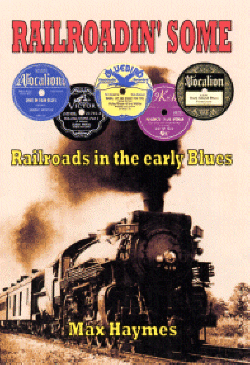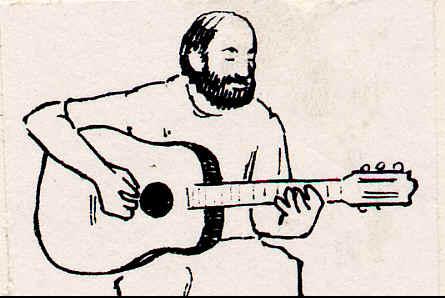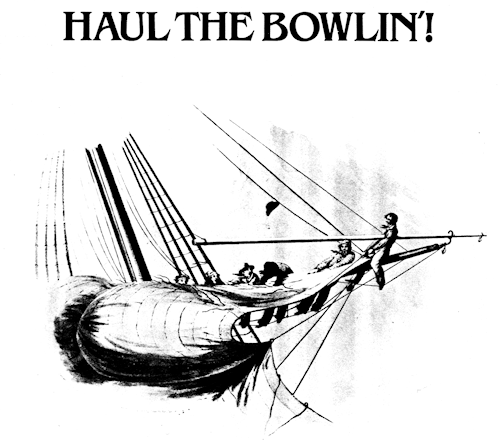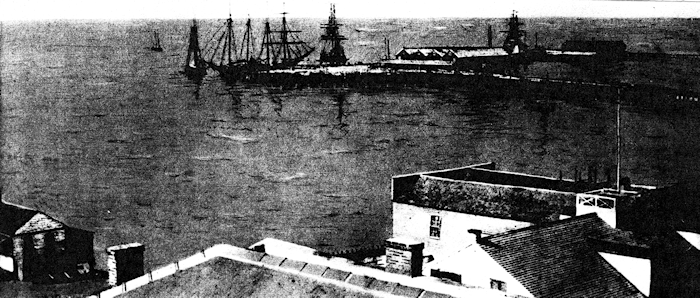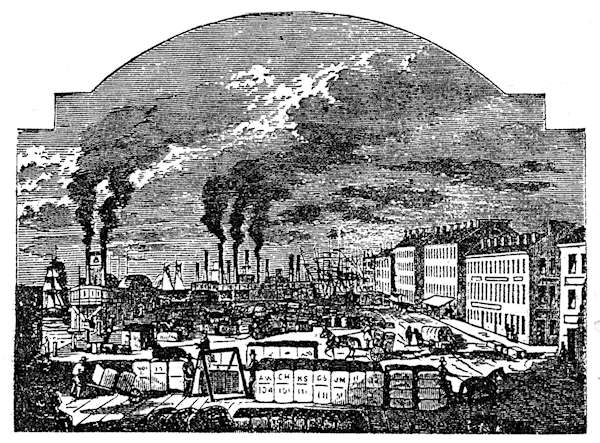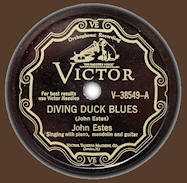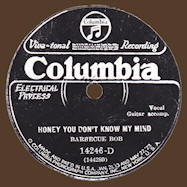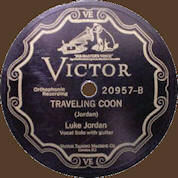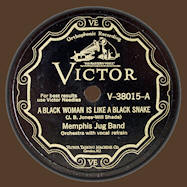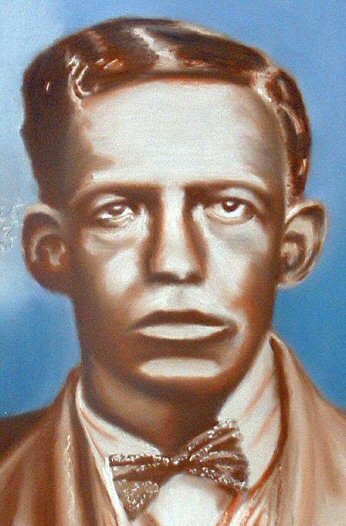
Painting © 2004 Loz
Arkle
Website
© Copyright 2000-2011 Alan White - All
Rights Reserved
Site optimised for Microsoft Internet Explorer
Blues At Sea |
||||||||||||||||||||||||||||||||||||||||||||||||||||||||||||||||||||||||||||||||||||||||||||||||||||||||||||||||||||||||||||||||||||||||||||||||||||||||||||||||||||||||||||||||||||
Chapter
I - Way Out 'Cross The Sea'
Other blues that make reference to the sea will be discussed in the final chapter. As will be seen, the above lines by Sleepy John Estes are by no means unusual in their allusion to the ocean: but where did Estes, a native of land-locked Tennessee, get his inspiration from? The short answer is, from the interaction of sea shanties by American and British sailors with other types of song, from home and abroad. All the states that were the main stamping grounds of the Blues singer, originally, had a coast line with the exception of Missouri, Arkansas and the aforementioned Tennessee. Even these had a shoreline along the mighty Mississippi which admitted some sea-going craft all the way up to St. Louis. The latter was a great centre for river/sea trade and the Blues in the early decades of this century. "From the earliest recorded times, sailors have given vent to more or less musical cries to help them work together on arduous ship-board tasks. As early as the fifth century the oarsmen of a Greek galley would get under way as they echoed phrases established by a lead singer." (2). The authors continue "The origin of the word 'shanty' to describe a sailor's work-song may likewise, be rooted in antiquity. It may be a version of the French 'chanter' or it may have found its way into naval parlance via the West Indies, where seaside huts or 'shanties' were moved away from their exposed positions with the approach of the hurricane season on great rollers hauled by teams of men. The men used to sing as they worked under the direction of a 'shantyman' perched on the ridge of each hut." (3). The navvies that built Britain's railways, often under horrific conditions, in the first half of the last century, lived in encampments of make-shift abodes referred to as 'shanty towns'. Meanwhile, Texas singer, Henry Thomas born c.1880, recorded his fine "Shanty Blues"
A levee camp song collected c.1933 by the Lomaxes includes the lines:
Whatever the origins, shanties spread in popularity in the early nineteenth century. They took various routes, criss-crossing the cultural sea many times. Lloyd says that the earlier American sea-going trading ships often consisted of crews of mixed nationalities: "Such men brought English shanties aboard American vessels, and took American shanties back into British ships. The musical accents of Liverpool and Louisiana, Cork and Cape Cod, Bethnal Green, Buckle and Baltimore went into the composition of the shanties, and the songs were all the better for the mixture." (6). In mid-nineteenth Gentry London, out-of-work sailors found other employment between sea-trips. Mayhew's list of 'Street-Sellers Of Live Animals' included "Foreigners, Jews, seamen ..." (7). These seamen would have heard, street-cries, music hall ditties, broadside ballads, etc, which would have sometimes partly lodged in their memory - only to reappear in the performing of another shanty when they were once more sea-bound. By the same token, shanties would be heard by many people trying to scrape a living on London's dockside. Mayhew makes reference to "a black sailor" and sailors singing "boisterous nigger songs from the Yankee ship just entering;" (8). He describes an operation of unloading casks of wine which involves six or eight men inside a wooden drum, grabbing hold of ropes and "...treading the wheel round, occasionally singing the while, and stamping time in a manner that is pleasant, from it's novelty." (9). The West Indies, as has been stated was another home of the sea shanty and could have transplanted this version of the marine work-song quite literally, as one method of oral transmission. "late in the 19th century an influx of Black West Indians and Bahamians started reaching a crescendo in the 1920's. At that time, newcomers from the West Indies made up one fourth of the population of Harlem." (10). A blues by vaudeville-blues singer, Clara Smith, recorded in New York City, reflects this influx; made in 1924 and titled "West Indies Blues". Long adds that "There was a smaller entry of Blacks from the Spanish-speaking areas of the Caribbean: Puerto Rico, Cuba, and the Dominican Republic. In New York City this incoming population created Spanish Harlem." (11). New York, of course is on the Eastern Seaboard of the United States and black dock workers have been a feature since at least the early part of the nineteenth century. Royal Navy captain and author, Basil Hall, visited the U.S.A. in 1827-28 and amongst his first impressions of New York was the following observation : "Negroes and negresses also were seen in abundance on the wharfs." (sic) (12). Some 42 years later it was reported that "... there are 3,500 colored seamen engaged in the mercantile marine service, sailing to and from the port of New York." (13). Further down the same coast, around 1859, an observer noted "I have stood for more than an hour, often listening to them (black stevedores in Philadelphia and Baltimore) as they hoisted and lowered the hogsheads and boxes of their cargoes; one man taking the burden of the song (and the slack rope) and the others striking in with the chorus. There was nothing religious in their songs." (14) In 1850, a shanty was observed on one of the 'Atlantic packets', the emigrant ship 'Washington', in an unusual role. A twelve year old child had died of dysentery (a not uncommon cause of death on some of these ships) and as no priest was available "The sailors were pulling at a rope, and raising their usual song:
and the child was thrown overboard at the sound of the last word of the song, which became a funeral dirge," (15) Most of the emigrant ships sailed from Liverpool for New York, Baltimore, Philadelphia, etc. but on average 68% arrived in New York in the years 1846, 1851 and 1855. But the Blues were formulated much further south than either New York, Philadelphia or Baltimore and any initial exchange of songs would have taken place at Gulf ports along the Eastern seaboard. As Hugill admits that in his book there are "... many instances... given of the railway gang songs of Negroes adapted by seamen as shanties. Then we have the labour songs of the Negro stevedores and wharf workers. These in the main came from the cotton stowers of the Gulf Ports - New Orleans, Mobile and so on." (16). Hugill quotes an American from 1857 who wrote "The men who yearly resort to Mobile Bay to screw cotton are, as may be imagined, a rough set. They are mostly English and Irish sailors who, leaving their vessels here, remain until they have saved a hundred or more dollars, then ship for Liverpool, London, or wherever port may be their favourite." (17). Hugill concludes "It is fairly obvious that the wharves of Mobile and such places were the meeting-ground of white men's songs and shanties and Negro songs and work songs ... The Gulf Ports could have been called the shanty mart or work-song exchange!" (18). At these shanty marts Hugill suggests that British sailors brought folk songs, presumably modified for the shanty, from Scotland, Ireland and England and 'swapped' them for work-songs from Southern blacks. Each would then mould the 'new' material to fit their own musical idiom. Although the origin of sea-shanties may be even more obscure than that of the Blues, there are several possible routes that these work-songs took, at least having influence on, and being influenced by, other songs, - as we have noted. As has already been discussed, one such route is the black work-song in the U.S. "... in the 1830's the loading of cotton on to the ships gave seamen many opportunities to listen to slave songs, the result being that the white sailors picked up Negro work-songs and took them to sea as shanties," (19). Then again Hugill tells us, "many of the shanties that appear to be developed from Negro sources may be white men's ditties taken to the West Indies by the slaves of the Monmouth Rebellion and, after being altered by the Negroes to suit their tastes, turning up again as Negro work-songs aboard sailing ships!" (20). However, he inadvertently gives a clue to an earlier example of the latter, blacks adopting white songs, which goes back to the beginning of slave traffic to the United States. Says Hugill, "... For work at the heavier and sturdier 'anchor capstan' or 'windlass situated on the 'fo'c'sle-head (the raised part of the deck at the bow) a slower type of capstan shanty or 'windlass shanty' would be used." (21) The fo'c'sle or forecastle was where male slaves were fed on voyage, as this horrific account of a mutiny reveals. In 1722 a captain was travelling as a guest of his fellow skipper Captain Snelgrave. The guest captain was up on deck at the time, unfortunately for him. "Being on the forecastle of the ship, amongst the men-negroes, when they were eating their victuals, they laid hold on him and beat out his brains with the little tubs, out of which they eat their boiled rice." (22). The practice of bringing the slaves up on deck for meals continued, out of necessity, into the 19th century. The slaves would have heard capstan shanties, and others, many times before they arrived on the Eastern coast of the U.S.A. After 1830 most of the crews of the American merchant ships were "...Irishmen and seamen from Liverpool and Scandinavia." (23) and it is at the Gulf ports that so much of the exchange of songs, referred to took place. In 1910 the "... five ports of Baltimore, Newport News, Norfolk and Portsmouth, New Orleans and Galveston, ... are entreports, for immense trade originating beyond the limits of the South." (24). Actually six, situated in the states of Maryland, Virginia, Louisiana and Texas. In the latter part of the 19th century the Georgia port of Savannah had a deep harbour at the mouth of the Savannah River and, like Charleston and Mobile, was one of the larger port cities between Baltimore and New Orleans. (25). In fact at one time "Savannah was the second-largest cotton port in the United States," (26) including a regular sea-traffic to and from New York. Galveston on the Texas coast was an important link between the Blues and sea shanties. Actually situated on an island some 2 miles from mainland Texas "The first railroad bridge was built to the mainland in 1858, and the city prospered with cotton as its major export." (27)
Things really began to take off after 1890 "when $6 million in U.S. government funds was obtained to build 5 miles (8km.) of jetties and to deepen the channel." (28). In 1898 there were at least 2,300 blacks working on the docks in Galveston where a speech on Aug 30th of that year by a black union leader was noted in defence of "... some 2300 Negro longshore members of the A.F. of L. in their strike against the Mallory lines in Galveston." (29). Another Texas port, Houston, was another link which depended mainly on the export of cotton, in the ten years leading up to the American Civil War, and on recovery from the latter, until on Nov. 10, 1914, the port was opened to international commerce ... The first oceangoing ship, the "Satilla", arrived at Houston in 1915." (30) All these ports would be visited by British, Irish and American sailors as well as many other nationalities. Not only sailors but Blues singers and their precursors, would travel all over the South including these coastal areas. As stated in the essay "British Colloquial Links And The Blues", the great Texas Bluesman, Blind Lemon Jefferson, was reported to have visited Alabama and towns along the Eastern Seaboard in the 1920's, amongst other places. Lemon was instrumental in perpetuating an image from the sea shanties of British sailors in the Blues, which fostered something of a 'tradition' in Texas. (see chapter II). Veteran banjo/jug player, Gus Cannon who had been born in Red Banks, Mississippi in 1883, recalls his younger days on the travelling medicine shows (see the essay "The English Music Hall Connection"); a regular feature in the South at the turn of the century. "I worked through Mississippi, I worked through Virginia, I worked through Alabama, I worked through Mobile, Gulfport Bay, St. Louis - as far as I been down, playin' my banjo on them doctor shows." (31) On Decatur Street in New Orleans, there were many bars, gambling saloons, dance halls, etc. where the Blues were to be heard in the earlier decades of this century. Trumpet player Dede Pierce recalls "Well at that time merchant seamen come in, get in some argument, try to tear up the place but the band continue playin' the blues, don't stop!" (32). Some of these merchant seamen would carry half-remembered images in the Blues back to their ships and incorporate them into their shanties. Not Just. American sailors, as Dede's wife, "Billie", who was a Blues singer, explains: "And around Decatur Street we had all kinds of nationalities. Everybody go around Decatur Street, come to the French market. All roll up - just about everyone: soldiers, sailors, merchant marine - everybody go until the wagon come." (33). A street singer "and occasional field-hand", Johnny 'Daddy Stovepipe' Watson claimed to have been born in 1870 and hailed from Mobile, Alabama. Together with his wife 'Mississippi Sarah', they travelled through the Southern states singing and playing, including of course the Gulf port. On "... the death of Sarah in 1937 he went South to Mexico and played with zydeco bands in Galveston and Houston, Texas," (34). Elsewhere, Oliver, when discussing Texas blues-piano players, relates that Black Ivory King, "... was one of the eastern group who worked the 'Flying Crow' line between his home town of Shreveport and Port Arthur on the Gulf Coast, where Ivory Joe Hunter knew him." (35). The 'Flying Crow' was a train on the M.K.T. line (Missouri - Kansas - Texas) known by Blues singers as 'the Katy' from a corruption of the phonetic property of these initials. 'Crow' reflects the practice of many U.S. railroads, in the days of steam, to paint their locomotives in an austere black. The punning significance of identification with his own 'colour', was eagerly taken up by the Blues singer. As in New Orleans, there was a healthy supply of 'blues joints' in the Texas seaports. Other pianists sometimes referred to as the 'Santa Fe' group, such as Andy Boy and Rob Cooper "... hailed from the ports of Galveston and Houston." (36), respectively. Many names, as elsewhere in the Blues, were never recorded and only their reputations are remembered. "Edgar Perry for instance, was acclaimed as the outstanding pianist of the group who worked the seaports but he too, was never to record." (37). In the previous decade (1920's), Houston's Blues scene was dominated by the Thomas family, George, Hociel, Hersal, Sippie, as well as a close family friend, one 'Moanin' Bernice Edwards. There were also itinerant blues men who travelled the length of the Eastern seaboard, "from the Gulf (of Mexico) to the Great Lakes" (38), such as pianists Cow Cow Davenport and Speckled Red and guitarists Big Joe Williams, Bukka White, as well as countless others. There were other, smaller ports where the song-exchange between Bluesman and sailor would have taken place; Biloxi, Pensacola and Apalachiola for example. The latter, Rogers tells us "... was served by four types of sailing vessels: ships (full square-rigged vessels of three masts, the aristocrats of the high seas), barks, brigs, and schooners ... Typically a New York-based ship unloaded its merchandise at Apalachiola, took on a cargo of cotton, and departed on a second leg to Liverpool or a European port." (39). Rogers adds "In Apalachiola most free blacks were transients, sailors who came into town from anchored ships." (40). Such was the feeling of racial tension at that time (during the American Civil War) that local legislation soon decreed that all black sailors should be kept on board until the day of their ship's departure. These ports, including the Gulf ports, ranged all the way down the Eastern Seaboard of the United States (see table 'A'). Ports are listed in geographical 'order' from north to south:
In 1910 "Savannah, New Orleans and Galveston, have a large European commerce;" (41), according to a writer at the time. The port that seemed to appear most in the sea shanties was that of Mobile. Described as a "city in southwestern Alabama ... about 160 miles southwest of Montgomery, the capital, and about 130 miles east of New Orleans," (42). The city "grew in prominence as a seaport handling the flourishing cotton trade." (43), in the earlier part of the nineteenth century.
Although the Civil War weakened it economically "...the port regained its vitality in the early 1900's." (44). By 1910 Hart declared "Mobile which is a place with increasing foreign commerce, can never hope to lead deep water to its present wharves, but about twenty-two miles below the city is an opportunity to bring large ships nearly inshore, and that is likely to be the future port of Mobile." (45). As in fact it turned out to be. He adds "Pensacola is the special favourite of the Louisville & Nashville Railroad, but seems to have no advantages which will bring it ahead of its neighbour Mobile." (46). The L. & N. was the subject of many a blues before World War II. It appears, for example, in "Scarey Day Blues" by Blind Willie McTell (1931), "Alabama Women Blues" by Leroy Carr (1930) and makes up the title of Walter Davis' recording of "L & N Blues" in 1933. The railroad acting as a continuation of the link from the Gulf ports, thus spreading any 'new' ideas that travelling Blues singers had heard in the sea shanties. References to the Alabamian city or to its bay are dotted throughout the sailors' repertoire. One shanty "John Come Tell Us As We Haul Away" has an "Alternative title, 'Mobile Bay'" (47). Hugill says this was originally ... a negro shanty used for pumping, " and "made the transition to steel ships as the sailors merely substituted the word 'heave' for 'pump"' (48). The shanty runs:
The deservedly famous Blues duo, Leroy Carr and Scrapper Blackwell, on the aforementioned "Alabama Women", recorded for posterity one of their most beautiful and sensitive blues, which commences:
The delicate phrasing of the piano, guitar, and Carr's vocal becoming an integrated whole. The singer is referring to two different railroads, the former being the G.M. & 0 (Gulf, Mobile and Ohio) usually referred to in the Blues as the 'M & 0'. Many Blues there were which also featured this line; such as "M & 0 Blues" by Willie Brown (1930), "Down by the M & 0" by Lee Brown (1939) and once again Walter Davis with a different "M & 0 Blues" to Willie Brown's, recorded in the same year. Carr and Blackwell seem to have drawn inspiration from the shanty 'Mobile Bay' and the latter crops up again in Chapter III. Another singer, who came from the Alabama bottomlands, Horace Sprott, was born of slave parents at some indeterminate date in the late 19th century. He "... had developed the trick of hearing a song through only once and having it right forever after." (51). During his long and chequered life, Sprott had "... worked in barrel-stave mills, snuff factories, packing plants, on the docks at Mobile Bay," (52) as well as jobs in other states.' He was by no means the only Blues singer who visited the Gulf port in Alabama and there were others who had his talent of perfecting songs after one hearing. They would have been within earshot of shanties sung by the sailors as they arrived at Mobile Bay from the Caribbean, Liverpool, and other parts of the world. "The Gulf ports for a while, ... increased the value of their exports 142.7 per cent in the twenty years after 1880, the ports of the South Atlantic gained only 56.8 per cent. In the two decades after 1892 export values from the Gulf ports nearly quadrupled. " (53) The Gulf ports were indeed work-song exchange centres, as Hugill called them and judging by the vast amount of 19th. c. merchant sea traffic coupled with the then emerging traditions and ramblings of the Blues singers, it would have been impossible for there not to have been so much interaction between the sea shanties and the Blues, in the closing decades of the last century. The Blues singer's ramblings via road and rail was to spread the influence of sea shanties throughout the Southern States of the U.S.A. © Copyright 1991 Max Haymes.
All Rights Reserved. Notes:
__________________________________________________________________________
Back
to essay overview
Website © Copyright 2000-2012 Alan White. All Rights Reserved. |
||||||||||||||||||||||||||||||||||||||||||||||||||||||||||||||||||||||||||||||||||||||||||||||||||||||||||||||||||||||||||||||||||||||||||||||||||||||||||||||||||||||||||||||||||||

